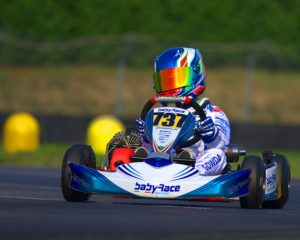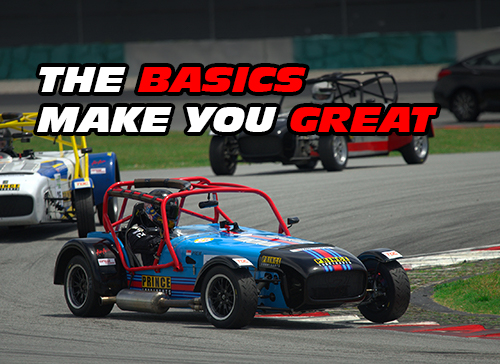“Michael Jordan at his peak as a pro started every practice with a chest-pass – the most fundamental movement in basketball. ” – Tim Grover (Jordan’s trainer)
You can easily find similar quotes about almost any high-level top performers. They keep working on the very fundamentals of the sport. Do you have a grasp of the basics of driving a race car? How often do you practice the basics?
If you don’t have a strong foundation, any weaknesses will quickly become your limiting factor. The basics when it comes to driving a race car are things such as how and when you get on and off the brakes. How you get onto the throttle, and how you shift gears.
Let’s make a simple list of some of the basics and break them down a bit:
- Braking Technique
- How to get on the brake.
- How to release the brake.
- How to maintain the proper amount of pressure through the braking zone.
- How to maintain the correct brake pressure while shifting down when doing heel & toe.
- Braking point consistency.
- Throttle Technique
- How to use the throttle on the straights.
- How to get onto the throttle when exiting a corner. When should it be instant, when should it be smooth? When should it start?
- How do you lift and get back off the throttle when shifting up?
- Shifting down – how do you blip the throttle?
- How do you recover from wheelspin using the throttle?
- Steering Technique
- Smooth, quick, when/how?
- Minimizing steering input through flat-out sections, making it as gradual as possible.
- Switching directions between 2 corners. Quick, slow?
- Shifting Technique
- How quickly do you shift up?
- How quickly do you shift down?
- How to time your down-shifts.
- When to short-shift, when not to short-shift.
- Response to oversteer/understeer/braking too late, etc.
- How do you react to oversteer moments?
- Are you comfortable with the car getting very loose?
- How do you react to understeer?
- How do you recover from braking too late?
- A common mistake for example is trying to force the car to the apex and making a small mistake a bigger one.
- Track use & racing line.
- Are you prioritising the correct corners in a sequence?
- Do you use all of the track when required?
- Do you use the curbs effectively, and know where and how to jump curbs?
That’s a quick list of the basics – if we’d expand it to a full list, you’ll quickly start to realise that the basics are 99% of driving a race car or kart. Sure it’s nice to be great at the 1% as well, but if you’re lacking in the basics, the 1% won’t do you much good.
It’s also possible to forget about some of the fundamentals, which is why it’s important even for the very best drivers to have a look at their basics every now and then.
It’s also about understanding why you do the basics the way you do. Properly understanding the basics also allows you to understand when and why you deviate from the “correct” way of doing things.
How well do you know the basics of vehicle handling dynamics?
Do you know what understeer and oversteer is? What does load transfer mean? Is load transfer the same as weight transfer? If you make the suspension softer, does that transfer load faster, or slower? There’s little need for a driver to become an engineer, but understanding the basics will improve your driving and understanding of setup. It will increase the awareness of what you’re doing.

Quick side-note:
If you’re a karting dad/mum/coach/mechanic reading this, I highly recommend asking your driver to explain what oversteer is. Ask them to explain it as they would to someone that is new to karting. Avoid making it a leading question – simply ask “How would you explain oversteer to a new driver?” and follow it up with the same question for understeer.
Don’t be surprised if the answer is along the lines of “Oversteer is when you steer too much, understeer is when you don’t steer enough.”
I’ve heard this answer more often than not from kids in the 9-12 year range, even if they’ve been driving for 2 or 3 years. Keep in mind it’s not their fault they don’t know it if they’ve never been taught it – they have just done their best to figure out what it means based on context and the word itself.
How can you practice the basics?
It’s not quite as simple as practicing a basketball or football pass. You can practice getting hard on the brake pedal when sitting still in your car – but that method doesn’t give you a lot of feedback if you’re doing it properly. You can the same with the throttle. or shifting gears. That’s fine for the simple mechanics of the movement, but not much else.
The key is deliberate, purposeful practice, with feedback. Driving a race car on track is a complicated process. There are a lot of things happening at the same time. Having a laser-like focus on one particular aspect of driving can help you focus on that one specific driving technique.
The feedback can be instant. Brake too hard and you lock up the tyres. It can also be more subtle cues that you are able to notice, but you should also have other ways to evaluate your performance. Video and data review for example are invaluable, ideally with a competent coach to assist. It’s important
If you want to focus on braking technique for example, you should ideally narrow it down further, and then spend a session (or two, or three) having that as your primary focus. You might for example focus on getting on the brakes faster, and at the correct pressure. That will take most of your concentration, and the rest of the driving is largely processed by your subconscious.
Another great idea is to turn your attention to a specific sense that can help you with the technique that you’re working on. If you’re working on braking for example, spend a session listening to every little detailed sound you can hear under braking. What does the engine and drivetrain sound like as you’re slowing the car down aggressively? How about as you trail off the brakes? Do you hear the tyres when you brake? What do the tyres sound like when you lock-up a tyre? You can do similar practice for what you see and feel as well, all with the goal of improving your sensory inputs. Improving your sensory inputs can improve your understanding of the specific thing you’re working on, and also improve your overall sensory capabilities.
Taking advantage of quiet or private test days allows you to do other things as well. For example you could practice straight-line braking on the straights, bringing the car to an almost stop, with the focus on initial braking technique, pressure/down-shifting, and/or brake release at the end of it as well.
Simulators can be amazing for practicing the basics. There’s no real penalty for crashing, and you can do things that you shouldn’t or can’t do on the real track. An example of a great exercise on a simulator is turning off the force feedback, and doing a skid pan
It’s important to know the limitations of simulators though. For example very few sims replicate shifting very well, so might not be the best solution for practicing shifting technique.
As for how to improve your understanding the the basics of vehicle dynamics – google is your friend. Lots of great books and articles to study from, as well as videos on youtube. It requires some study, but once you’ve done the study, you’ll be able to observe what you’ve learned happening as you drive.
The basics are what separate the good drivers from the amateurs, and the great drivers from the good ones. Work on your basics!

